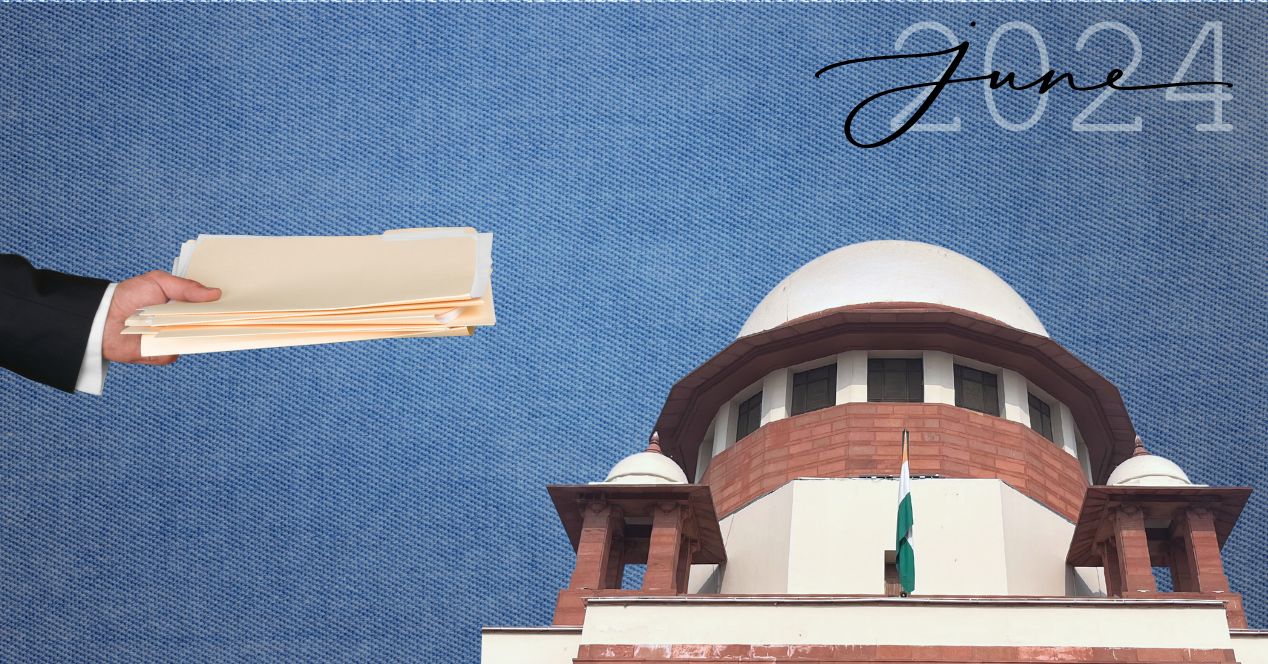Court Data
July 2024: Most number of cases filed and disposed so far this year
On its return from summer vacation, the Court in July notched a healthy average daily disposal rate of 365 cases

On 8 July 2024, the Supreme Court returned to action after a seven-week summer break. More cases were instituted in the Court in July than any other month so far this year. But a well-rested Court also disposed of more cases, reducing overall pendency by over 900 cases.
Institution refers to new cases entering the Court during a specific period. Disposal refers to the number of cases resolved by the Court, either by delivering a judgement or final order, or by dismissal, thereby clearing them from the Court’s docket.
5949 cases instituted 6198 disposed of
Figure 1 shows a month-wise breakdown of the number of cases instituted and disposed of by the Supreme Court this year.
Note: The data for July was collected from the National Judicial Data Grid on 16 August 2024 at 11.27am.
As seen in Figure 1, July marks the month when the most cases were both instituted (5949) and disposed (6198) this year.
The uptick in activity was expected after the long summer break but the numbers are worth remarking on since the Court only worked for 17 days and was two judges short of its full sitting strength of 34 for half the month. Justices Kotishwar Singh and R. Mahadevan were elevated to the top court on 18 July to fill the vacancies caused by the retirements of Justices Aniruddha Bose and A.S. Bopanna.
This means that the Court cleared an average of 365 cases per day—the highest average daily disposal of any month this year.
To put these numbers in perspective, let’s take a quick look at the institution and disposal rates in the first half of the year.
In January, the Court worked for 20 days, receiving 4964 cases and disposing of 5453. A seven-judge Constitution Bench heard arguments for seven days that month.
February saw a slight dip in institution and disposal numbers, with 4821 cases filed and 5409 cleared. However, disposal still exceeded institution numbers as the Court worked with full strength that month for 21 days. Seven- and nine-judge Constitution Benches sat for seven days in this month.
In March, there was a reversal of the trend of more disposals than filing, with 4656 cases instituted and 3926 disposed of. This could be attributed to the week-long Holi break, which meant the Court had only 15 working days in March. Additionally, nine judges of the Court were occupied in an all-day Constitution Bench hearing for five days this month.
April saw an increase from March in the number of cases filed (5613) and disposed (4813). Nine-judges were occupied across two Constitution Bench hearings over 10 days this month.
In May, the Court had only 13 working days before it broke for summer vacation on the 20th. The Court received 5418 cases and disposed of 3610.
June, being a full month of summer vacation, saw an expected drop in institution, with 2643 cases being filed. Vacation Benches of the Court cleared 613 matters in this period.
Highest institution in July since 2020
Figure 2 maps the number of cases instituted and disposed of in July since 2020. Data for the years 2020 to 2023 is sourced from the Annual Reports of the Supreme Court. Month-wise split for previous years is unavailable on the National Judicial Data Grid.
As seen in Figure 2, there were more cases instituted in July this year compared to the last four years (going back to 2020). This year’s disposal rate was also healthy.
But the 6198 cases disposed in July 2024 still fell short of the 7770 cases disposed in July last year. In July 2023, the Court disposed of 1572 more cases than this year. There isn’t a big difference between the daily average disposal rate in the two years (365 a day in July 2024 compared to 370 a day in July 2023). So last year’s higher disposal number could be attributed to the fact that the Court had four more working days compared to this year.
Note: In our ongoing series of monthly updates on case institution and disposal at the Supreme Court, we have also been monitoring the data consistency between the National Judicial Data Grid (NJDG) and the Supreme Court's Justice Clock website.
The Justice Clock is hosted on the web page of the Supreme Court registry. The NJDG, on the other hand, contains data from the Supreme Court, High Courts, and district and taluka courts and is managed by the Department of Justice. We have observed occasional delays in the transfer of data from the Supreme Court to the NJDG.
While the numbers aligned for February and March, we observed discrepancies in January, April. We also noticed slight variations in May and June.
There appears to be a slight discrepancy in the data between the two platforms for July as well. The NJDG recorded an institution of 5949 cases and a disposal of 6198 cases. The Justice Clock recorded an institution of 5952 cases and disposal of 6419 cases (221 cases more than NJDG).




